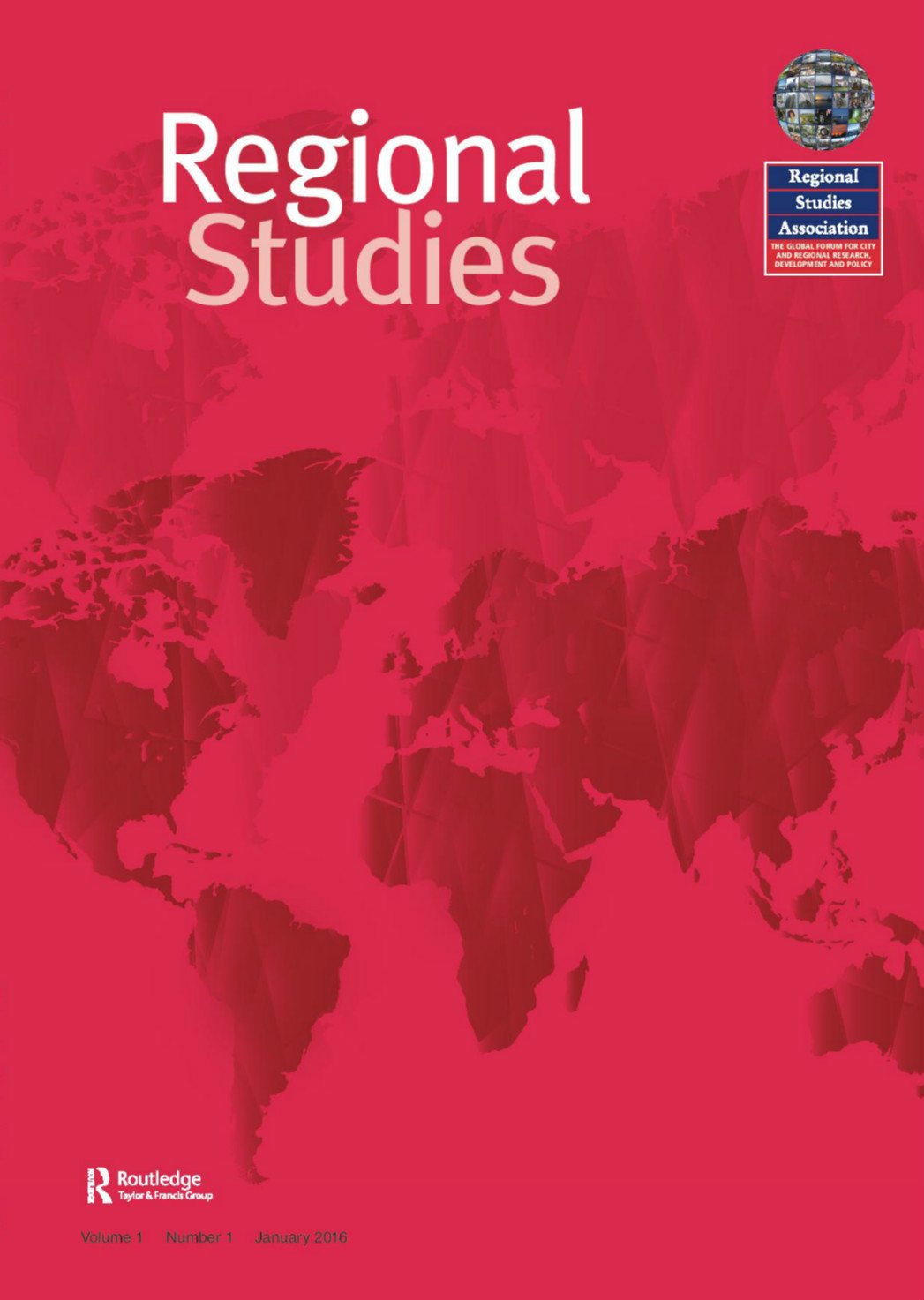Editors’ Pick

The Editors’ Pick: from the editors’ desk
The editors pick section is the part of Regions eZine that highlights the most interesting and innovative work being published across the Regional Studies Association’s five journals. In each issue, we ask the editors of Regional Studies, Regional Studies Regional Science, Territory, Politics, Governance, Spatial Economic Analysis and Area Development and Policy to pick one article from their journal that has been recently published and to explain what makes that piece of work significant. In so doing, we would like to try to demystify the editorial process and to provide an examples of what John Harrison describes in his Research Hack article, as “wave” and “splash” making papers, or papers that have something to say.
Area Development and Policy

Managing Editors: Michael Dunford & LIU Weidong, Chinese Academy of Sciences
Patronage and politics in the Nelson Mandela Bay Municipality, by Crispian Olver.
Area Development and Policy (ADP) has published a number of articles on aspects of African urbanization (Arthur, 2018; Lawanson & Agunbiade, 2018; Pieterse, Parnell, & Haysom, 2018; Turok, 2016). In the next issue it will publish another, dealing with a major corruption scandal in Nelson Mandela Bay Municipality (Olver, 2018). The article is remarkable in that it is written by a scholar who was appointed to an organization tasked with turning around the performance of the municipality, where in 2016 the African National Congress (ANC) lost political control, and has played a role inside the ANC in cleaning up local politics.
Concretely, attention is paid to property sales and leasebacks, a contracted out rapid transit system and to a variety of aspects of the public resource allocation system and management. The significance of this article lies however in the degree of insight it provides into the relationships between party politics and public allocation in a South African context and the way it unravels accounts that conflate the experiences of different African countries, contributing to the more general mission of ADP (Dunford et al, 2016).
A good number of articles deal with national transition in South Africa since the establishment of multi-party representative democracy and the arrival of the ANC in power in 1994. In South Africa change involved the devolution of political power and fiscal decentralization. As in many other parts of the world a ‘democratic’ political order was captured by private business elites and in the South African case also by a political class able to extract rents (revenues that exceed costs) and private and party political gains from the public allocation of contracts, regulatory approvals, grants, subsidies and appointments. As a result, it failed to meet the needs of significant sections of the population, as is the case in many other countries characterized by capitalist market economies and this model of governance.
In a situation in which technical and managerial capabilities at a local scale were limited, in which the ‘structural violence of poverty and marginalization’ remains widespread and where accession to middle class lifestyles for many remains tenuous and dependent on political appointments and access to state resources, what emerged was a relatively (but fairly well-resourced) system of local government and factional politics. Crispian Olver explains how different factions struggled for control over public resources and sought to consolidate loyalty and power by trading political offices, jobs, contracts, cash and other resources. However, the existence of a narrow group of beneficiaries made this model of politics ultimately unsustainable as it was inconsistent with party political programmes and commitments and the delivery of services to urban residents. Aided moreover by the subcontracting out of core functions, the establishment of a political market and the outsourcing in some cases of control over public allocation weakened the party and further weakened the patronage state.
As Crispian Olver emphasizes, however, South Africa ‘is a middle income country with a relatively well-functioning system of democracy in which the legislative, judicial and executive institutions of the state, while under attack to varying degrees, still function. The political marketplace operates in parallel to the institutions of the state, and while it has at times overwhelmed certain state components, on the whole it remains subordinated to them’.
What is clear therefore is that this article deals with an issue of major contemporary concern, it draws of first-hand experience that researchers seldom enjoy, and it provides significant insights into the specific causal mechanisms moving forward the analysis of urban politics and resource allocation.
Territory, Politics, Governance

Editor in Chief: John Agnew, University of California Los Angeles
Hannah Arendt’s Spatial Thinking: An Introduction, by Bernard Debarbieux.
In Bernard Debarbieux’s recent article “Hannah Arendt’s Spatial Thinking: An Introduction.” Debarbieux highlights the tragic dimensions of nation-statehood in his introduction to the spatial thinking inherent in Hannah Arendt’s understanding of modern politics. More particularly, he shows the ways in which Arendt opens up how much nationalism came to naturalize the link between state and nation and the extent to which modern statehood rested on the redefinition of property in terms of private ownership licensed by the state as opposed to the earlier sense of simple location within a body politic. This is accomplished within the contours of a broad reconsideration of Arendt as a thinker with much to offer to contemporary efforts at reworking connections between territory, politics and governance. Not least, of course, it suggests how much we need to think in terms other than nation-states such as regions of various spatial magnitudes when considering politics and governance.
Spacial Economic Analysis

Editor in Chief: Paul Elhorst, University of Groningen
Measuring Regional Inequality: to weight or not to weight? by Konstantin Gluschenko
The paper Measuring regional inequality: to weight of not to weight? by Konstantin Gluschenko published in volume 13 of Spatial Economic Analysis is featured because the reviewers agreed that this piece of work might radically change the way of thinking about the determination of regional inequality measures in the future. The paper challenges the work of many previous studies, too many to mention them even in the paper itself. The author claims that the common practice of population-weighting when calculating indices of regional inequality, such as the Theil, Gini and the Williamson coefficient, might lead to inconsistent outcomes. To illustrate this, he provides several simple numerical examples, as well as mathematical formulae. In addition, he shows that population-weighted indices violate the anonymity principle, the principle of transfers and do not have unambiguous maxima. Since inequality is and remains an important issue in regional science, reading this paper is a must.
Regional Studies Regional Science

Editors in Chief: Alasdair Rae, University of Sheffield & Stephen Hincks, University of Sheffield.
The impact on welfare and public finances of job loss in industrial Britain, by Christina Beatty and Steve Fothergill
As Editors, we love to see papers making an impact, so we were delighted to see the positive response to ‘The impact on welfare and public finances of job loss in industrial Britain’ by Christina Beatty and Steve Fothergill from the Centre for Regional Economic Social Research at Sheffield Hallam University.
This paper is both very important and extremely timely. Why? It is important because it takes the reader from the history of industrial decline in Britain, through the large-scale loss of jobs in the 1980s and 1990s and up to the present Government’s austerity welfare policies. In doing so, it shows how the impacts of recent welfare reforms, combined with a legacy of industrial decline, has been a double blow for many of the poorest places in Britain. This issue of geographical unevenness is woven into the fabric of the paper. It is also very timely because it speaks to issues directly relevant to Brexit and the communities often thought to be ‘left behind’ or ‘forgotten’: those which are also often ‘blamed’ for the result. The authors show, very clearly and very carefully, how our future situation is connected to our past and, in particular, the destruction of industrial Britain. This has been bad for individuals, but it has also had a serious impact upon the national welfare bill, as the authors describe:
“Allowing Britain’s industrial base to wither so dramatically has not been costless and it has certainly not been absorbed by the smooth operation of market forces. It has resulted in persistent worklessness, low wages and an inflated welfare bill.”
Most importantly of all, the authors do not stop at description. Instead, they discuss whether there is an alternative approach that might work and they set out some clear lessons for those in power.
We are glad they chose to publish in RSRS because this is exactly the kind of paper that needs to reach a wide audience and, being a gold open access journal, it has done so. Since being published in Volume 4 (2017) it has been downloaded more 1,200 times in a field where 500 is sometimes considered ‘going viral’ and it currently has an Altmetric Attention Score of 49, placing it comfortably among the top 5% of papers published at the same time. And, last but not least, it has been selected as Best Paper for 2017 at the RSA Annual Awards Ceremony in November 2018.
Regional Studies

Editor in Chief: David Bailey, Aston University, UK
Understanding citizen perception of European Union Cohesion Policy: the role of the local context, by Roberta Capello and Giovanni Perucca